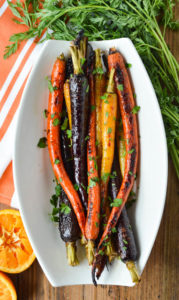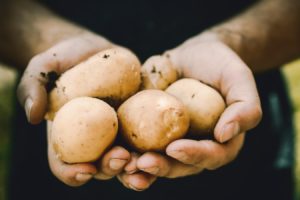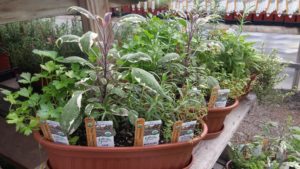Gardener’s Guide: What to Grow for Thanksgiving
With Thanksgiving only four days away, home cooks are rushing to the supermarkets to stock up on their favorite sweet and savory fixings. But wouldn’t it be great if your pumpkin pie or sweet potato casserole could be baked using fresh pumpkin and sweet potatoes grown right from your backyard? In this Gardener’s Guide, we’ll tell you exactly what to grow for Thanksgiving (and how to do it), so unfasten your belts; you’re in for a tasty treat.
Traditional Thanksgiving Sides
In 1621, the Wampanoag and the Pilgrims joined together at Plymouth Colony for the very first Thanksgiving. While turkey was certainly served, this famous dinner didn’t include what we think of as “traditional” Thanksgiving sides. Potatoes and sweet potatoes hadn’t yet been introduced in North America, so the family-favorite mashed potatoes and gravy and sweet potato casserole weren’t enjoyed then. The pilgrims also didn’t have access to butter or wheat flour, so pumpkin pie wasn’t on the menu either.
What was on the menu?
Not much. According to letters written by pilgrims who attended the feast, the main course consisted of turkey, fowl, and venison. Sides mainly included Indian Corn, eaten on the cob or in porridge and bread. On the Wampanoag side, there would have been seafood, such as eel; fish; lobsters; clams; and mussels.
Based on what the English liked to grow in their gardens, historians speculate that there may have also been beans, carrots, turnips, onions, garlic, nuts, and pumpkin at this feast, some of which would have been used to stuff their birds.
So what should you grow in your garden for next Thanksgiving? Below, we’ve outlined gardening tips for growing the vegetables in our favorite side dishes.
Gardening for a Feast
If you’re wondering what sides to cook this Thanksgiving and how to grow the ingredients yourself, you’re in luck. Here are our favorite veggie sides!
Glazed Rainbow Carrots
These root vegetables add bright pops of flavor to savory dishes. If you plan to harvest carrots around Thanksgiving, plan to plant them anywhere from two to four months in advance.
To plant carrots, first make sure the conditions are right. You want to plant carrots in full sunlight and in loose, sandy soil. (You do not want to plant carrots in clay or silt.) Prepare the soil by freeing it of any rocks or soil clumps, as these can stunt your carrots’ growth. When the soil is ready, sow the seeds 1/4 inch deep, 3-4 inches apart and cover with soil. You can also cover with some compost to keep a hard crust from forming.

To tend to your carrots, keep them watered. When you poke a finger through the soil, it should be moist to your knuckle. You should water one inch every week; once the roots mature, you should water two inches every week. You should also mulch the soil to keep any sunlight from directly hitting the roots. And always member to weed your garden.
Here’s our favorite recipe for Brown Butter Maple Glazed Roasted Rainbow Carrots.
Sweet Potato Casserole
Sweet potatoes take at least three months to mature, and they prefer warmer climates. For those living in the south, this is no problem. For those in the north, however, growing sweet potatoes for Thanksgiving can be a challenge. Though challenging, it isn’t impossible for northerners to enjoy home-grown sweet potatoes in November, as sweet potatoes can be grown indoors. In this article, we’ll only discuss how to grow sweet potatoes in a garden, but if you’d like to learn how to grow them indoors, we recommend reading this article from The Spruce.
To grow your sweet potatoes, you’ll need what is called slips. Because sweet potatoes are tubers, they’re not grown from seeds. Rather, they’re grown from small rooted pieces of tuber that are cut from the bottoms of other sweet potatoes. You can either procure your own slips from sweet potatoes in your kitchen or you can buy them from your local gardening center. (Note: if you procure your own slips, there are some extra steps you will need to take before planting them in your garden.)
To plant your sweet potato slips, first till the soil 8-10 inches deep. Make sure your soil is well-drained. Create 7-inch tall, 12-inch wide mounds in your garden bed and then plant your slips in these mounds. You’ll want to plant them 12 inches apart and deep enough that the roots and 1/2 an inch of the stem are completely covered. Keep your potatoes watered and your bed weeded, but do not prune the vines. You can also fertilizer your potatoes with a high-phosphorous fertilizer solution for a larger harvest.
Once the leaves have turned yellow, you can begin harvesting your sweet potatoes by loosening the soil and digging them up.
Sweet potato casserole isn’t complete without marshmallows, so see our favorite (and simple!) Sweet Potato Casserole with Marshmallows Recipe.
Mashed Potatoes
It’s not enough to just have sweet potatoes; every Thanksgiving dinner table needs a whopping bowl of mashed potatoes and gravy, too.
For northerners, you can grow potatoes throughout the summer and into the fall, but not after the first frost hits. Southerners, on the other hand, can grow potatoes in the fall, winter, and spring. The earliest you can plant potatoes is after the last spring frost.
 To plant potatoes, first make sure the soil is well-drained and rich in nutrients. To do this, you can mix in some compost.
To plant potatoes, first make sure the soil is well-drained and rich in nutrients. To do this, you can mix in some compost.
In your garden bed, dig 6-inch wide, 8-inch deep trenches. Space your rows three feet apart. You’ll want to add manure or compost to the bottom of these trenches, then add your cut potatoes 13 inches apart. Cover these potato slices with three to four inches of soil.
Remember to water your potatoes one to two inches every week and to make sure no sunlight hits the tubers in the ground. To keep your potatoes from getting sunburned, you should hill them, which entails raking dirt up around the base of the plant into a hill or mound to block the sunlight.
Potatoes take two to four months to grow, so if you plan to make mashed potatoes for Thanksgiving using your own potatoes, plan to plant them anywhere from July to September.
For one fantastic mashed potatoes recipe, check out Center Cut Cook’s Cream Cheese and Sour Cream Mashed Potatoes recipe!
Creamed Brussel Sprouts
Now, we know that brussel sprouts aren’t exactly a fan-favorite… And on their own, well, they don’t exactly deserve to be on our Thanksgiving favorites list.
But don’t skip this section just yet. Below is a recipe that will knock your socks off and get everyone (not just your dog) to eat these veggies!
Brussel sprouts are a cool-season crop and prefer temperatures between 45 and 70 degrees Fahrenheit. If you live in the north, then you’re in luck because brussel sprouts love the frost. Planting in the south, however, might not be possible if your intention is to harvest them for Thanksgiving day.
To grow your own transplants, plant brussel sprout seeds 1/4 to 1/2 an inch deep in containers for about three to four weeks. When you transplant them into your garden, plant the seedlings 15 inches apart in full sun. As with your potatoes, you’ll want to use well-drained, fertile soil. Water regularly to keep the soil moist.
Brussel sprouts take 90-100 days to grow, which is great for northerners who can get a head start in the summer.
Ready for the recipe? Here’s a cheesy and delicious Creamed Brussel Sprouts recipe to replace the frozen creamed spinach you may have served in the past.
Pops of Flavor
And what’s Thanksgiving without the signature tastes of parsley, sage, rosemary, and thyme?
You can grow these herbs in pots outside or inside as long as you remember to use lots of water and fertilizer. Fertilize your herbs every four weeks, and remember to provide them plenty of sunlight.

These herbs can be added to your Turkey as it’s cooking; stuffing; mashed potatoes; roasted vegetables; and soups.
There you have it! Now you know what to grow for Thanksgiving, how to do it, and how to incorporate your harvest into tasty recipes! But wait…there’s more.
Don’t Forget to Feed your Plants
Remember, you aren’t the only one who needs to eat this Thanksgiving! Plants need food, too.
Remember to fertilizer your vegetables and herbs according to their specific needs. Nitrogen is vital for plants, and vegetables need more of this nutrient than phosphorous and potassium. It is important, however, to avoid using too much nitrogen, as it can stunt plant growth and lead to runoff.
xVital, our all-natural nitrate fertilizer, is the superior choice for vegetable gardens. Because it contains only nitrate and ionized water, it doesn’t negatively affect plants. Other fertilizers contain salts and chemicals, which can burn your plants’ roots.
In addition, our fertilizer is easy to use. Simply go to our online ratio calculator and determine how much fertilizer you need to add to water to create the perfect blend for your vegetables.
Sources:


